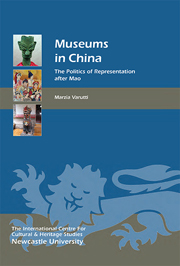Book contents
- Frontmatter
- Contents
- List of Illustrations
- Acknowledgments
- Chronology
- List of Abbreviations
- Introduction
- 1 Cultural Heritage in China
- 2 Museums in China: origins and Development
- 3 New Actors in the Chinese Museum World
- 4 Museum objects and the Chinese nation
- 5 The nation in the Museum
- 6 The Politics of the Past
- 7 The Representation of the Past in China's Museums
- 8 The Politics of identity
- 9 The Museum Representation of ethnic Minorities
- 10 Techniques and sites of Display of ethnic Minorities
- Conclusions: The new Museums of China
- Appendix: List of Museums in China Visited by the Author
- Bibliography and References
- Index
- Heritage Matters
4 - Museum objects and the Chinese nation
Published online by Cambridge University Press: 05 March 2014
- Frontmatter
- Contents
- List of Illustrations
- Acknowledgments
- Chronology
- List of Abbreviations
- Introduction
- 1 Cultural Heritage in China
- 2 Museums in China: origins and Development
- 3 New Actors in the Chinese Museum World
- 4 Museum objects and the Chinese nation
- 5 The nation in the Museum
- 6 The Politics of the Past
- 7 The Representation of the Past in China's Museums
- 8 The Politics of identity
- 9 The Museum Representation of ethnic Minorities
- 10 Techniques and sites of Display of ethnic Minorities
- Conclusions: The new Museums of China
- Appendix: List of Museums in China Visited by the Author
- Bibliography and References
- Index
- Heritage Matters
Summary
This chapter explores how museums interpret objects in order to create and disseminate specific narratives of the Chinese nation. Since the process of representation begins with the interpretation of objects, it seems fitting to consider object biographies, and how these influence the ways in which objects are interpreted. How have specific objects endured over time and what contexts have they encountered during their ‘social life’? How have museum practices (documentation, research, conservation, exhibition) affected their meanings and values, and to what extent are new meanings created in the museum?
One can think of museum displays as assemblages ‘of people, things, ideas, texts, spaces, and different media’ (Macdonald and Basu 2007, 9) which bear the ‘capacity, through the studied manipulation of the relations between people and things in a custom-built environment, to produce new entities that can be mobilized — both within the museum and outside it — in social and civic programmes of varied kinds’ (Bennett 2005, 525). By removing objects from their original contexts and placing them in an artificial, ad hoc environment, museums alter the perception and meaning of objects, as well as changing interrelations among objects, and between objects and persons (Bennett 2005, 523ff). By putting specific objects on display and by linking them through narratives, museums contribute to shaping individual and collective understandings of identities, the past, present and future.
- Type
- Chapter
- Information
- Museums in ChinaThe Politics of Representation after Mao, pp. 59 - 76Publisher: Boydell & BrewerPrint publication year: 2014

